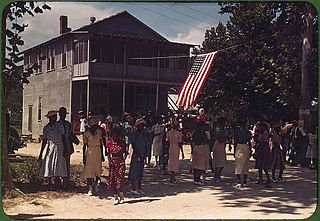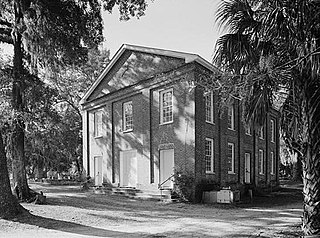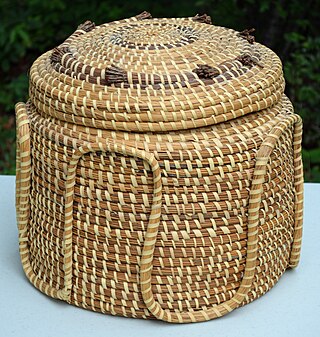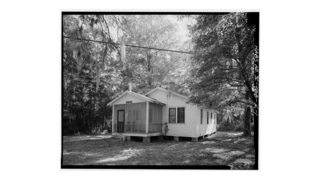
Beaufort is a city in and the county seat of Beaufort County, South Carolina, United States. Chartered in 1711, it is the second-oldest city in South Carolina, behind Charleston. Beaufort is known as the "Queen of the Carolina Sea Islands". The city's population was 13,607 at the 2020 census. It is part of the Hilton Head Island–Bluffton metropolitan area.

The Gullah are a subgroup of the African American ethnic group, who predominantly live in the Lowcountry region of the U.S. states of South Carolina, North Carolina, Georgia, and Florida within the coastal plain and the Sea Islands. Their language and culture have preserved a significant influence of Africanisms as a result of their historical geographic isolation and the community's relation to their shared history and identity.

The Sea Islands are a chain of over a hundred tidal and barrier islands on the Atlantic Ocean coast of the Southeastern United States, between the mouths of the Santee and St. Johns rivers along South Carolina, Georgia and Florida. The largest is Johns Island, South Carolina. Sapelo Island is home to the Gullah people and all islands are acutely threatened by sea level rise due to climate change.

St. Helena Island is a Sea Island in Beaufort County, South Carolina, United States. The island is connected to Beaufort by U.S. Highway 21. The island has a land area of about 64 sq mi (170 km2) and a population of 8,763 as of the 2010 census. It is included as part of the Hilton Head Island-Beaufort Micropolitan Area. The island is renowned for its rural Lowcountry character and being a major center of African-American Gullah culture and language. It is considered to be the geographic influence behind the children's television program Gullah Gullah Island.

Daufuskie Island, located between Hilton Head Island and Savannah, is the southernmost inhabited sea island in South Carolina. It is 5 miles (8 km) long by almost 2.5 miles (4.0 km) wide – approximate surface area of 8 square miles (21 km2). With over 3 miles (5 km) of beachfront, Daufuskie is surrounded by the waters of Calibogue Sound, the Intracoastal Waterway and the Atlantic Ocean. It was listed as a census-designated place in the 2020 census with a population of 557.

The South Carolina State House is the building housing the government of the U.S. state of South Carolina, which includes the South Carolina General Assembly and the offices of the Governor and Lieutenant Governor of South Carolina. Located in the capital city of Columbia near the corner of Gervais and Assembly Streets, the building also housed the Supreme Court until 1971.

The 16th Street Baptist Church is a Baptist church in Birmingham, Alabama, United States. In 1963, the church was bombed by Ku Klux Klan members. The bombing killed four young girls in the midst of the Civil Rights Movement. The church is still in operation and is a central landmark in the Birmingham Civil Rights District. It was designated as a National Historic Landmark in 2006. Since 2008, it has also been on the UNESCO list of tentative World Heritage Sites.

Special Field Orders, No. 15 were military orders issued during the American Civil War, on January 16, 1865, by General William Tecumseh Sherman, commander of the Military Division of the Mississippi of the United States Army. They provided for the confiscation of 400,000 acres (160,000 ha) of land along the Atlantic coast of South Carolina, Georgia, and Florida and the dividing of it into parcels of not more than 40 acres (16 ha), on which were to be settled approximately 18,000 formerly enslaved families and other black people then living in the area.

Rufus Saxton was a Union Army brigadier general during the American Civil War who received America's highest military decoration, the Medal of Honor, for his actions defending Harpers Ferry during Confederate General Jackson's Valley Campaign. After the war he served as the Freedmen's Bureau's first assistant commissioner.

The 1st South Carolina Volunteer Infantry Regiment (Colored) was a Union Army regiment during the American Civil War, formed by General Rufus Saxton. It was composed of escaped slaves from South Carolina and Florida. The 1st SC Volunteer Infantry black regiment was formed in 1862 and became the 33rd United States Colored Troops Regiment in February of 1864. It has the distinction of being the first black regiment to fight in the Civil War at the Skirmish at Spaulding's on the Sapelo River GA. It was one of the first black regiments in the Union Army.

Joseph A. Opala, OR is an American historian noted for establishing the "Gullah Connection," the historical links between the indigenous people of the West African nation of Sierra Leone and the Gullah people of the Low Country region of South Carolina and Georgia in the United States.

The Penn Center, formerly the Penn School, is an African-American cultural and educational center in the Corners Community on Saint Helena Island. Founded in 1862 by Quaker and Unitarian missionaries from Pennsylvania, it was the first school founded in the Southern United States specifically for the education of African-Americans. It provided critical educational facilities to Gullah slaves freed after plantation owners fled the island, and continues to fulfill an educational mission. Leigh Richmond Miner photographed students and activities at the school.

The Camp Saxton Site is a 6-acre (24,000 m2) property located in Port Royal, South Carolina. It was listed in the National Register Historic Places on February 2, 1995.

The Gullah-Geechee Cultural Heritage Corridor is a federal National Heritage Area in the United States. The intent of the designation is to help preserve and interpret the traditional cultural practices, sites, and resources associated with Gullah-Geechee people. Gullah-Geechee Cultural Heritage Corridor, and the federal Gullah-Geechee Cultural Heritage Corridor Commission established to oversee it, were designated by an act of Congress on October 12, 2006 through the National Heritage Areas Act of 2006.

The Birmingham Civil Rights National Monument is a United States National Monument in Birmingham, Alabama established in 2017 to preserve and commemorate the work of the 1963 Birmingham campaign, its Children's Crusade, and other Civil Rights Movement events and actions. The monument is administered by the National Park Service. Civil rights protesters took to the streets of Birmingham, Alabama to fight in favor of Project C, a campaign against laws limiting African Americans freedoms. They were met with violent resistance from the police.

The Freedom Riders National Monument is a United States National Monument in Anniston, Alabama established by President Barack Obama in January 2017 to preserve and commemorate the Freedom Riders during the Civil Rights Movement. The monument is administered by the National Park Service. The Freedom Riders National Monument is one of three National Monuments that was designated by presidential proclamation of President Obama on January 12, 2017. The second was the Birmingham Civil Rights National Monument and the third, the Reconstruction Era National Historical Park, was re-designated as a National Historical Park on March 12, 2019.
The United States Civil Rights Trail is a heritage trail in the Southern United States that provides visitors with stories about the civil rights movement stories at various landmarks. The Civil Rights Trail links historically important Black churches, school museums, civil rights leaders’ residences, courthouses, and other landmarks of the civil rights movement in the 1950s and 1960s and the creation of the U.S. Constitution’s 13th, 14th and 15th amendments.

Benezet House, also known as Benezette House, is an historic dormitory located on the campus of Penn Center. It was erected in 1905 and named after Frenchman, Anthony Benezet, who stood for freedom in the mid- and late-1870's. The female teachers and female boarding students of Penn School were housed here. The mandatory nightly chapel service held in the ground floor lobby was, however, open to both male and female students. This location was the focal point of home economics training for female students, each of whom were required to reside in Benezet before they graduated. Today, Benezet House is used to house overnight guests to Penn Center.

The Retreat House and Dock of Penn Center, formerly known as Penn School, was built in 1968, the year Dr. Martin Luther King, Jr. was killed. Plans were for him to have his meetings there rather than the smaller Gantt Cottage he had been staying at. It faces a body of water, a cove of Capers Creek, which is a place for meditation and relaxation for Penn Center's guests. The Retreat House replaced the Palmetto Cottage built in 1920 which was formerly located at this site but was destroyed by fire in the 1950’s. The Retreat House and Dock was however used by Dr. Martin Luther King, Jr.'s associates during the Charleston Hospital Strike of 1969.

The original Gantt Cottage located on the campus of Penn School, now known as Penn Center, was named after the ex-enslaved Hastings Gantt, who donated the original tract of land for Penn School to Laura Towne. It was destroyed by fire around 1940. The current house, built by students, is a replacement. Mr. Gantt was a businessman and politician. He served in the South Carolina Legislature as a representative from Beaufort during the Reconstruction period. During the 1960’s Dr. Martin Luther King, Jr. stayed at Gantt. Penn Center was one of the few places in the south where bi-racial groups could meet. Planning for the great Civil Rights “March on Washington” took place here as well as the writing of the "I Have a Dream" speech.

























